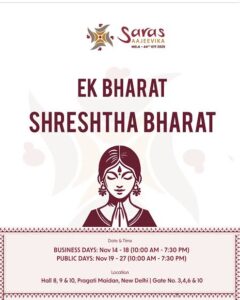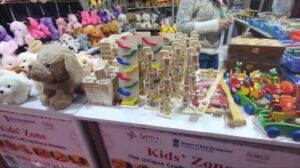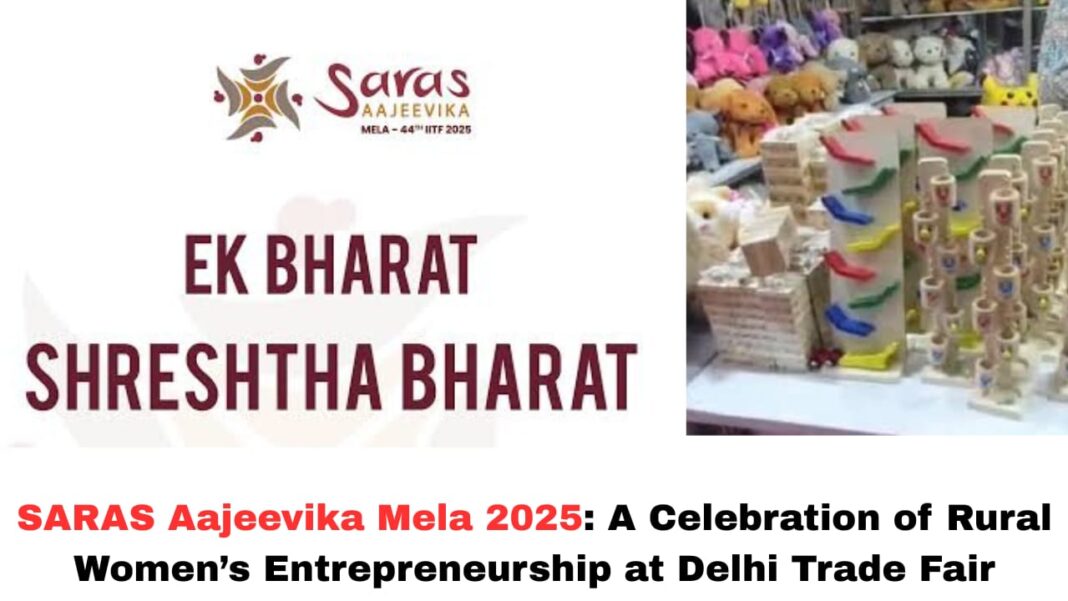Digital News Guru New Delhi Desk:
SARAS Aajeevika Mela Shines at Delhi’s 44th India International Trade Fair
In a vibrant display of tradition, culture, and economic empowerment, the SARAS Aajeevika Mela has been launched as a key feature of the 44th India International Trade Fair (IITF) at Bharat Mandapam, New Delhi. This government-backed initiative, anchored in the spirit of rural self-reliance, brings together hundreds of women entrepreneurs from across the country to showcase handcrafted products, regional delicacies, and their entrepreneurial spirit.
A Platform for Rural Women Entrepreneurs
The SARAS Mela is organized by the Ministry of Rural Development under the Deendayal Antyodaya Yojana – National Rural Livelihoods Mission (DAY-NRLM), an effort to strengthen self-help groups (SHGs) in rural India.

This year, more than 400 rural women belonging to SHGs from all corners of India are participating in the event, bringing their craftsmanship and food items to nearly 200 stalls. These women, sometimes referred to as “Lakhpati Didis,” are not just selling products — they are building businesses, earning livelihoods, and gaining wider market visibility.
More Than Just a Marketplace
While the fair is clearly commercial in nature, what makes it distinct is its dual role as a cultural showcase and an educational platform. Rather than just trading goods, SARAS provides an immersive “experience” for visitors who can explore traditional arts, learn about regional traditions, and taste authentic local cuisine.
The Mela’s structure is organized into three special pavilions:
- Knowledge Pavilion: This is where SHG women attend workshops on practical business skills — covering topics like financial literacy, product design, packaging, and digital marketing.
- Experience Pavilion: Here, live craft demonstrations and food-preparation sessions give visitors a real-time insight into how items are made. Inspiring stories of “Lakhpati Didis” — women whose SHG income crosses 1 lakh — are shared here.
- Convergence Pavilion: This is a space for coordination between different government ministries (like MSME, livestock, food processing) and SHG women to help them access schemes, resources, and market linkage.
Products, Crafts, and Flavours on Display
The diversity of items on sale is a testament to India’s rich cultural heritage. From handloom sarees — such as Patola, Kantha, Chanderi — to woollens, wooden crafts, and eco-friendly home decor, there’s a wide variety of traditional handicrafts. Food stalls in the fair feature regional delicacies: pickles, jams, pulses, and snacks prepared by rural women, bringing a gustatory dimension to the experience.
More than just traditional goods, the Mela is helping its participants make a leap into modern commerce. Many SHG women have already partnered with major e-commerce platforms like Amazon and Flipkart, and some products from previous editions of SARAS have even reached international markets.

Empowerment Through Entrepreneurship
At its core, the SARAS Aajeevika Mela is about economic empowerment. By offering a national platform, it turns micro-enterprises into viable businesses. For many women, running a stall is more than an income source — it is a symbol of independence and recognition.
According to participants and organizers, the Mela also contributes to capacity building: SHG members receive training in digital literacy, bookkeeping, and market-ready product design. This kind of support helps them transition from informal, local-scale producers to serious entrepreneurs capable of scaling up.
The Mela is deeply aligned with the “Vocal for Local” ethos, urging consumers to appreciate and support locally-made rural products.
Impact and Significance
The importance of SARAS goes beyond commerce. It is a cultural bridge — connecting urban buyers with the craftsmanship and traditions of rural India. Visitors to the Mela don’t just shop; they also experience regional heritage, learn about the social impact of these businesses, and celebrate rural women’s creativity.
On the social development front, the Mela strengthens the mission of the DAY-NRLM by validating the entrepreneurial ambitions of SHG women. By enabling them to earn, save, and reinvest in their communities, SARAS contributes to poverty reduction, women’s empowerment, and sustainable livelihoods.
Challenges and Opportunities
However, running such a large-scale Mela is not without challenges. For many rural women, logistics, production scale, and meeting quality standards for a broader market can be difficult. Ensuring that training and follow-up support (post-Mela) is sustained will be key to their long-term success.
Moreover, while the Mela helps in market exposure, establishing consistent demand beyond the fair period is critical. For SHG entrepreneurs to thrive, they need stable, recurring channels — whether through e-commerce, recurring city fairs, institutional buyers, or export markets.

On the opportunity side, the convergence of government support (through schemes), capacity building, and digital marketing is powerful. If leveraged effectively, it could help SHG-led micro-enterprises become not just subsistence-level but truly scalable businesses.
Looking Ahead
The SARAS Aajeevika Mela at the 44th IITF is a fitting symbol of how rural women’s self-help initiatives are transforming India’s economic and cultural landscape. As visitors browse through stalls, interact with artisans, and sample regional delicacies, they are not just consumers — they are part of a larger narrative: that of empowerment, tradition, and change.
For the SHG women — the “Lakhpati Didis” — the Mela is more than a fair. It is validation. It is a market. It is an opportunity to grow. For the country, it’s a reminder that the strength of India’s economy lies not only in its big cities, but in its villages — where skill, tradition, and entrepreneurship converge.
As the fair continues, the hope is that many of these women return home not just with sales receipts, but with a vision: of scaling their businesses, reaching new customers, and inspiring others. SARAS Aajeevika Mela may only run for a few weeks, but for these entrepreneurs, its impact lasts much longer.
You May Also Read: Vijayawada–Singapore Direct Flights Resume After 7-Year Hiatus








